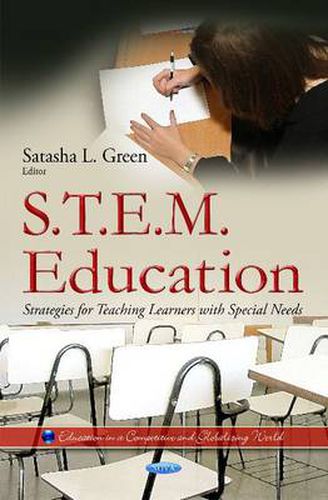Readings Newsletter
Become a Readings Member to make your shopping experience even easier.
Sign in or sign up for free!
You’re not far away from qualifying for FREE standard shipping within Australia
You’ve qualified for FREE standard shipping within Australia
The cart is loading…






Advancing education in science, technology, engineering, and mathematics (STEM) in U.S. public schools has been at the forefront of educational issues and a national priority (President’s Council of Advisors on Science and Technology, 2010). Although there is a need for this ambitious initiative, students with disabilities has been left out of the conversation. Individuals with disabilities have been underrepresented in STEM fields for many years. Traditionally individuals with disabilities in STEM careers lag even further behind discrepancies of race and gender in these areas. Therefore, the need to provide general and special education teachers practices and strategies to improve outcomes for students with disabilities in STEM areas is imperative. The nation’s changing demographics and continued need to remain globally competitive makes it clear that general and special education teachers need strategies to support, instruct and engage students with disabilities in STEM education. Students in U.S. schools are academically behind their international peers in STEM areas. Currently, the United States ranks 17th in science and 25th in mathematics among other nations (National Center for Education Statistics, 2011). In the field of engineering, college programs in China and India graduated many more engineers than in the U.S. (Gerefii, Wadhwa, Rissing, & Ong, 2008). For example, in 2011, China’s engineering graduates totaled one million (Shammas, 2011), as compared to colleges in the U.S. which graduated 84,599 engineers (Deffree, 2012).
$9.00 standard shipping within Australia
FREE standard shipping within Australia for orders over $100.00
Express & International shipping calculated at checkout
Advancing education in science, technology, engineering, and mathematics (STEM) in U.S. public schools has been at the forefront of educational issues and a national priority (President’s Council of Advisors on Science and Technology, 2010). Although there is a need for this ambitious initiative, students with disabilities has been left out of the conversation. Individuals with disabilities have been underrepresented in STEM fields for many years. Traditionally individuals with disabilities in STEM careers lag even further behind discrepancies of race and gender in these areas. Therefore, the need to provide general and special education teachers practices and strategies to improve outcomes for students with disabilities in STEM areas is imperative. The nation’s changing demographics and continued need to remain globally competitive makes it clear that general and special education teachers need strategies to support, instruct and engage students with disabilities in STEM education. Students in U.S. schools are academically behind their international peers in STEM areas. Currently, the United States ranks 17th in science and 25th in mathematics among other nations (National Center for Education Statistics, 2011). In the field of engineering, college programs in China and India graduated many more engineers than in the U.S. (Gerefii, Wadhwa, Rissing, & Ong, 2008). For example, in 2011, China’s engineering graduates totaled one million (Shammas, 2011), as compared to colleges in the U.S. which graduated 84,599 engineers (Deffree, 2012).